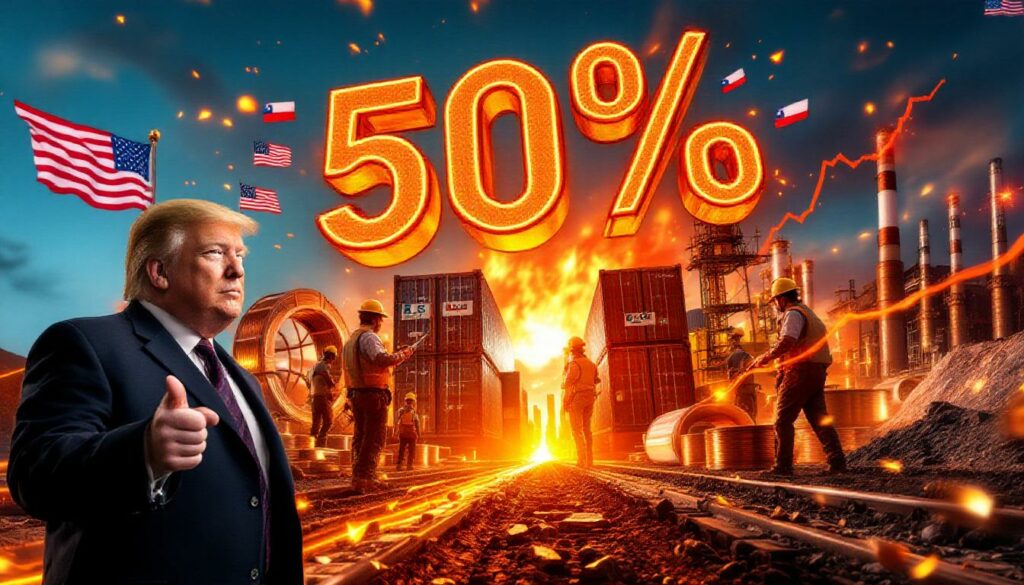What Is Trump's New Copper Tariff Policy?
Understanding the 50% Tariff Announcement
On July 9, 2025, President Trump announced via his Truth Social platform that the United States would implement a 50% tariff on imported copper. This significant trade policy measure is scheduled to take effect on August 1, 2025, giving market participants and industry stakeholders approximately three weeks to prepare for the changes.
The announcement, as reported by SMM (Shanghai Metal Market) on July 10, 2025, represents one of the most aggressive trade measures on copper imports in recent U.S. history. The relatively short implementation timeline has created immediate market reactions and raised concerns across global supply chains.
Key Details of the Tariff Implementation
While the announcement did not specify exclusions or exceptions, the 50% tariff appears to apply broadly to imported copper in various forms. This comprehensive approach differs from previous metal tariffs that often included country-specific exemptions or product carve-outs.
The three-week notice period before implementation is notably brief for such a significant trade action, potentially creating challenges for importers with copper shipments already in transit. Industry analysts are closely monitoring whether the administration will provide technical implementation guidance before the August 1 effective date.
Practical implications include:
- Immediate price arbitrage opportunities between international and U.S. markets
- Accelerated shipments to beat the August 1 deadline
- Contract renegotiations across supply chains
- Potential stockpiling by major industrial consumers
Disclaimer: The tariff policy details are based on the initial announcement. Implementation specifics may evolve as the effective date approaches, and stakeholders should monitor official government communications for updates.
How Did Markets React to the Tariff Announcement?
Immediate Price Movements in Copper Futures
The announcement triggered an immediate and substantial reaction in the copper futures market. According to SMM reporting on July 10, 2025, copper futures on the New York Mercantile Exchange (NYMEX) experienced a sharp upward movement:
- The most-traded COMEX copper September contract expanded gains by 2.6%
- The August contract saw even larger gains of 3%
- Trading volume increased significantly as market participants repositioned
This price surge occurred within hours of the announcement, demonstrating the market's sensitivity to potential supply constraints in the world's largest economy.
Broader Market Implications
The immediate price reaction reflects market expectations that the tariff will significantly reduce copper imports into the U.S., creating potential supply constraints in the domestic market. This movement is particularly notable considering copper's status as a bellwether industrial metal often referred to as "Dr. Copper" for its ability to predict broader economic trends.
The price increase comes against a backdrop of already tight global copper supply forecast and growing demand from renewable energy and electric vehicle sectors. Furthermore, market analysts note that the tariff announcement may accelerate several existing trends:
- Increasing premiums for immediately available physical copper in U.S. markets
- Widening spreads between COMEX and LME (London Metal Exchange) prices
- Growing interest in domestic copper production assets
- Heightened volatility in derivatives markets
The price reaction highlights copper's critical role in modern industrial supply chains and the market's sensitivity to potential disruptions.
Why Is This Tariff Significant for the Copper Industry?
U.S. Copper Import Dependence
The United States has gradually increased its reliance on imported copper over recent decades as domestic production has struggled to keep pace with surging copper demand. This import dependency creates vulnerability to supply disruptions and price fluctuations resulting from trade policy changes.
Key factors driving U.S. copper import dependency include:
- Declining ore grades at mature U.S. mining operations
- Permitting challenges for new domestic projects
- Growing demand from electrification initiatives
- Cost advantages of integrated overseas producers
The 50% tariff represents a significant intervention aimed at reshaping these long-established trade patterns, potentially incentivizing domestic production while raising input costs for copper-dependent industries.
Global Supply Chain Disruptions
The copper market operates as a complex global ecosystem with mining concentrated in regions like South America and processing capacity distributed across China, Europe, and North America. The 50% tariff represents a major disruption to these established copper supply chains.
Major copper exporters to the U.S. will face significant challenges, including:
- Finding alternative markets for their copper
- Potentially reducing production
- Negotiating new trade arrangements
- Absorbing part of the tariff cost to remain competitive
The tariff's implementation will likely accelerate the regionalization of copper supply chains, with producers increasingly focused on serving nearby markets to minimize trade policy exposure.
Industry Insight: Copper's unique properties of conductivity, ductility, and corrosion resistance make it difficult to substitute in many applications, meaning downstream industries have limited short-term alternatives to absorbing higher prices.
Who Will Be Most Affected by the Copper Tariff?
Domestic U.S. Copper Producers
U.S.-based copper mining companies and smelters stand to benefit significantly from the tariff protection. Companies with major domestic copper operations could see improved profit margins and increased market share as imports become less competitive.
Major U.S. copper producers that may benefit include:
- Freeport-McMoRan (operates major mines in Arizona and New Mexico)
- Rio Tinto (Kennecott Utah Copper operations)
- ASARCO (Arizona mining operations)
- Nevada Copper (Pumpkin Hollow mine)
The tariff could potentially revitalize interest in developing domestic copper resources that were previously considered marginally economic, particularly in mining districts across Arizona, Utah, Nevada, and Michigan.
International Copper Exporters
Countries with significant copper exports to the U.S. will face substantial challenges. Chile, as the world's largest copper producer and a major U.S. supplier, will be particularly impacted despite having a free trade agreement with the United States.
Other affected exporters include:
- Peru (second-largest global copper producer)
- Canada (significant refined copper supplier)
- Mexico (benefits from proximity and USMCA)
- Australia and Indonesia (growing suppliers)
These exporters must now evaluate their options for redirecting shipments to alternative markets or absorbing portions of the tariff to maintain U.S. market access.
Downstream Industries
Industries that rely heavily on copper as an input will likely face increased costs that could impact their competitiveness and pricing strategies:
| Industry | Copper Usage | Potential Impact |
|---|---|---|
| Electrical Equipment | High (wiring, transformers) | Significant cost increases |
| Construction | Moderate to High (plumbing, wiring) | Project cost escalation |
| Automotive | Increasing (EVs use 3-4× more copper) | EV affordability challenges |
| Electronics | Moderate (circuit boards, connectors) | Margin pressure |
| Renewable Energy | High (wind turbines, solar) | Project ROI reduction |
Manufacturing companies with global production footprints may accelerate shifting copper-intensive production outside the U.S. to access lower-cost materials, potentially offsetting some of the tariff's intended benefits for domestic producers.
What Are the Potential Economic Consequences?
Price Effects on Domestic Copper
The tariff is expected to create a significant price premium for copper in the U.S. market compared to global prices. This differential could create several market dynamics:
- Incentivized domestic production: Higher effective prices make marginal U.S. deposits more economically viable
- Increased stockpiling: Consumers may build inventory ahead of the August 1 implementation
- Arbitrage opportunities: Traders may exploit regional price differences where possible
- Recycling acceleration: Secondary copper sources become more economically attractive
The magnitude of the price premium will depend on several factors, including the elasticity of domestic supply, the availability of substitutes, and the degree to which exporters absorb a portion of the tariff rather than passing it to customers.
Inflationary Pressures
Higher copper prices could contribute to broader inflationary pressures in the U.S. economy, particularly in sectors where copper is a significant input cost. Construction projects, electrical infrastructure, and manufacturing could all face higher costs that may ultimately be passed on to consumers.
The inflationary impact may be felt through several channels:
- Direct material cost increases for copper-intensive products
- Project delays or cancellations as economics shift
- Substitution with more expensive alternatives where possible
- Secondary price increases as the effects ripple through supply chains
These pressures come at a time when many industrial sectors are already navigating other tariff market impacts and input cost fluctuations, potentially compounding their economic impact.
Economic Context: Copper's unique role as both an industrial metal and financial asset means price increases can simultaneously signal industrial cost pressures and attract speculative investment, potentially amplifying market moves.
How Might Other Countries Respond?
Potential Retaliatory Measures
Countries affected by the copper tariff may implement countermeasures targeting U.S. exports. This could escalate into broader trade tensions affecting multiple sectors beyond metals and mining.
Historically, trade partners have responded to unilateral U.S. tariffs by targeting politically sensitive U.S. exports such as:
- Agricultural products (soybeans, corn, pork)
- Consumer goods (bourbon, motorcycles)
- Industrial outputs (aircraft, machinery)
- Energy products (LNG, petroleum products)
The risk of escalation depends on several factors, including the significance of U.S. copper imports to exporting countries, existing trade tensions, and the political calculus of affected governments.
Alternative Trade Arrangements
Major copper producers may accelerate efforts to develop alternative markets, particularly in regions with growing copper demand such as:
- China: World's largest copper consumer with continued infrastructure development
- India: Rapidly expanding electrical grid and manufacturing base
- Southeast Asian economies: Growing industrial production and urbanization
- European Union: Renewable energy initiatives driving copper demand
This market diversification could lead to new trade patterns and potentially more regional pricing for what has traditionally been a globally priced commodity.
Some producers may also explore value-added processing before export to avoid the tariff on raw copper, accelerating the development of downstream industries in copper-producing regions.
What Are the Long-Term Industry Implications?
Investment in Domestic Copper Production
The tariff could stimulate increased investment in U.S. copper mining and processing facilities. Projects that were previously considered marginally economic might now become viable with higher effective domestic prices.
Key projects that could see accelerated development include:
- Dormant mines in historic copper districts (Michigan, Arizona)
- Expansion projects at existing operations
- Advanced exploration projects near permitting stage
- Processing capacity for secondary (recycled) copper
However, mining investments typically require multi-year timeframes and substantial capital, meaning the supply response may lag significantly behind the tariff implementation.
Technological Adaptations
Higher copper prices might accelerate several technological trends:
- Development of copper alternatives: Materials like aluminum, aluminum-copper alloys, or carbon nanotechnology
- Efficiency improvements: Designs that reduce copper intensity without sacrificing performance
- Advanced recycling technologies: Methods to recover copper from complex waste streams
- Substitution with other materials: Where technical requirements permit
These adaptations typically require significant R&D investment and time to implement, meaning short-term options for copper-dependent industries remain limited.
Structural Market Changes
The copper industry may see structural changes including:
- Realignment of global trade flows: New supplier-customer relationships forming outside traditional patterns
- Vertical integration strategies: Companies securing their supply chains through ownership
- Changes in inventory management: Increased strategic stockpiling
- New pricing mechanisms: Regional premiums becoming more significant than global benchmark prices
These structural changes could persist even if the tariff policy is eventually modified or reversed, as supply chains once redirected are costly to reconfigure.
How Does This Fit Into Broader Trade Policy?
Comparison to Other Metal Tariffs
The 50% tariff on imported copper represents a more aggressive approach compared to previous metal tariffs implemented during Trump's earlier administration, which included:
- 25% tariff on steel imports (Section 232, 2018)
- 10% tariff on aluminum imports (Section 232, 2018)
- Various targeted tariffs on specific products and countries (Section 301)
The substantially higher rate (50% vs. 10-25%) signals an escalation in trade policy interventions and could set precedents for other commodity markets.
Strategic Objectives
The copper tariff appears aligned with broader trade policy objectives focused on:
- Reducing trade deficits: Copper represents a significant import category for the U.S.
- Protecting domestic manufacturing: Supporting U.S. producers facing international competition
- Leveraging trade policy for geopolitical advantage: Creating negotiating leverage with trading partners
- Reshoring critical supply chains: Reducing dependence on foreign sources for strategic materials
These objectives reflect a continuation of the shift toward more interventionist trade policies that began during the previous Trump administration, suggesting potential further actions in related sectors.
What Should Industry Stakeholders Do Now?
Preparing for Implementation
With the August 1 implementation date approaching, industry participants should consider:
- Reviewing supply contracts and pricing mechanisms: Assess force majeure clauses and price adjustment provisions
- Evaluating inventory positions: Consider accelerating imports or building safety stock
- Assessing alternative sourcing options: Explore domestic suppliers or product redesigns
- Developing price risk management strategies: Investigate hedging instruments and forward contracts
The limited preparation time makes immediate action critical, particularly for companies with significant copper imports scheduled near the implementation date.
Long-Term Strategic Planning
Beyond immediate preparations, companies throughout the copper value chain should:
- Reassess capital investment plans: Review the economic viability of projects under new pricing scenarios
- Evaluate vertical integration opportunities: Consider securing upstream or downstream assets
- Consider geographic diversification: Spread production across multiple trade jurisdictions
- Develop scenario planning: Prepare for potential policy changes and market responses
These strategic considerations should account for both the direct effects of the tariff and potential second-order impacts such as retaliatory measures or supply chain realignments.
Strategic Insight: Companies that adapt quickly to the new market realities may find competitive advantages, while those slow to respond risk margin compression or loss of market share.
FAQs About the Copper Tariff
Will the 50% tariff apply to all forms of copper imports?
While the announcement didn't specify exclusions, tariffs typically apply to raw materials, semi-finished, and finished products containing the targeted metal. Specific exemptions may be announced before implementation.
Companies should review the Harmonized Tariff Schedule classifications for their specific copper imports and monitor for potential product-specific guidance from U.S. Customs and Border Protection.
How will this affect copper prices globally?
Global copper prices may experience increased volatility and potential regional price differentials, with U.S. domestic prices likely commanding a premium over international benchmarks.
The magnitude of this premium will depend on several factors:
- The elasticity of U.S. demand
- The responsiveness of domestic supply
- The ability of exporters to absorb portions of the tariff
- The effectiveness of trade diversion to alternative markets
Could the tariff be challenged through trade organizations?
Affected countries may challenge the tariff through the World Trade Organization or seek exemptions through bilateral negotiations, though such processes typically take significant time.
Previous metal tariffs faced similar challenges, with mixed results. The WTO dispute settlement process can take years, meaning companies should plan for the tariff to remain in effect for the foreseeable future regardless of potential challenges.
How might this impact copper mining investments?
The tariff could accelerate investment in domestic U.S. copper projects while potentially slowing development in countries that heavily rely on the U.S. export market.
However, mining investments typically require:
- Multi-year development timelines
- Substantial capital commitments
- Confidence in long-term policy stability
This means that while investment sentiment may shift quickly, actual production changes will lag significantly behind the tariff implementation.
Will recycled copper be subject to the same tariff?
The announcement did not specifically address recycled copper, but import tariffs typically apply to materials regardless of whether they are virgin or recycled unless specifically exempted.
This creates significant opportunities for domestic copper recycling operations, which may see improved economics and increased investment as a result of the tariff policy. For those interested in capitalizing on these changes, exploring various copper investment strategies will be essential in the coming months as market conditions evolve in response to the new copper price insights.
Ready to Spot the Next Major Mineral Discovery?
Discovery Alert's proprietary Discovery IQ model instantly notifies ASX investors of significant mineral discoveries before the broader market reacts, providing actionable insights that can lead to substantial returns. Explore historic examples of exceptional outcomes on our dedicated discoveries page and begin your 30-day free trial today to secure your market-leading advantage.




